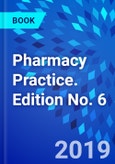The sixth edition of Pharmacy nPractice brings the contents completely up to date, reflecting emerging new roles for pharmacists both within the traditional employment areas of hospital and community pharmacy, as well as other developing roles supporting the public health agenda, governance, risk management, prescribing and pharmaco-economics.
- Each chapter begins with Study Points and ends with Key Points to reinforce learning.
- Appendices include medical abbreviations, Latin terms and abbreviations, systems of weights and measurements and presentation skills.
- Some chapters also carry self-assessment questions for more complex areas of pharmaceutical practice.
- New editor on the team, Louise Cogan.
- Many new contributors, comprising practising pharmacists, teachers of pharmacy, and pharmacists with joint appointments between hospital/community pharmacy and universities.
- Now with companion e-book included on StudentConsult
New chapters on
- Consent
- History Taking/ Gathering Information
- Advice giving and the pharmacist as a Health Trainer
- Using calculations in pharmacy practice
- Continuing professional development and revalidation
- Intra and inter professional working, The role of the pharmacist in medicines optimization
Table of Contents
Section 1: The Patient- Socio-behavioural aspects of health and illness
- Socio-behavioural aspects of treatment with medicines
- Communication skills for pharmacists and their team
- Consent
- History Taking/ Gathering Information
- Concordance
- Advice giving and the pharmacist as a health trainer
Section 2: The Medicine
- Control of medicines
- The prescribing process and evidence-based medicine
- Drug evaluation and pharmacoeconomics
- Formularies in pharmacy practice
- Complementary and alternative medicines
- Using calculations in pharmacy practice
- Veterinary pharmacy
Section 3: The Medicine Formulation
- Dispensing techniques (compounding and good practice)
- Oral unit dosage forms
- Packaging
- Solutions
- Suspensions
- Emulsions
- External preparations
- Suppositories and pessaries
- Powders and granules
Section 4: The Specialized Pharmacy Product
- Production of sterile products
- Parenteral products
- Opthalmic products
- Inhaled products
- Parenteral nutrition and dialysis
- Radiopharmacy
- Specialized services
- Appliances
Section 5: The Pharmacy Safety Process
- Clinical governance
- Risk management
- Standard operating procedures
- Audit
- Information retrieval in pharmacy practice
- Control of health professionals and their staff
- Continuing professional development and revalidation
Section 6: The role of pharmacy in healthcare
- The role of pharmacy in healthcare
- Ethics - the theory
- Ethics in practice and ethical dilemmas
- Public health
- Structure and organization of pharmacy
- Intra- and inter-professional working
Section 7: The patient, their medicine and beyond
- The prescription
- Patient charges of medicines and their impact on access
- Routes of administration and dosage forms
- Labelling of dispensed medicines
- Monitoring the patient
- The role of the pharmacist in medicines optimisation
- Public health and pharmacy interventions
- Substance use and misuse








